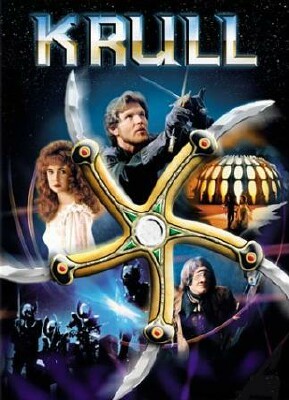The story starts with the dreaded Beast taking over worlds with evil
intentions and his army horde, called Slayers. His latest attempt at
conquest is the world of Krull, and though they are formidable, the Slayers
are able to defeat the Krull armies due to their lack of unity. The
Krull leaders decide to form an alliance, symbolized through the marriage of
Prince Colwyn (Marshall, Feds) and Princess Lyssa (Anthony,
Dracula: Dead and Loving It), to unite their
kingdoms and the armies opposing the Beast. Lyssa has been foretold to
be the mother of the future ruler of the galaxy, and the Beast has his sights
on making her a bride of his own, so before the marriage ceremony is complete,
a major attack takes place seeing the deaths of both kings of Krull, the
abduction of Princess Lyssa (now Queen), and only Prince Colwyn left alive to
avenge the slaughter. Colwyn must head to the mysterious Black Fortress,
the Beast's elusive lair, in order to vanquish the Beast and rescue Lyssa, but
before he can do that, he must find the ancient five-pronged throwing weapon
called the Glaive. With help from an old seer, a bumbling magician, a
ragtag group of prisoners, a Cyclops, and others, Colwyn goes on the strange
odyssey to the Black Fortress, encountering nothing but dangers and madness
along the way.
A relatively high budget went mostly to bolstering the visual elements of
Krull, concentrating primarily on many special effects shots, scenic
locales, and grandiose set design. Though many of these effects are
dated, some are still very impressive, such as a scary trip into the center of
a formidable web protected by a nimble, giant spider. The design of the
interiors of the Black Fortress itself is also very appealing, with its
serpentine design and reptilian adornments -- those who have ever played the
modern-day role playing game of "Oblivion" might conclude that the film
provided some visual inspiration, especially the scenery upon entering an
Oblivion Gate. As impressive as these components might be, they aren't
quite enough to generate a much-needed sense of excitement in the
overly-familiar quest of gallant warrior out to save the damsel from the
clutches of evil through bravery and mythical weapons.
Liabilities abound, perhaps most notably in the fairly wooden lead performance
of Ken Marshall as Colwyn, who exhibits a certain handsome nobility, but
lacks the charisma and panache to ever make his character truly exciting to
watch. However, Lysette Anthony does make for a fetching princess,
though there is obvious dubbing of her voice (the producers wanted an American
actress, so Lindsay Crouse's (Slap Shot)
voice was used), and the supporting cast is solid, with bit parts given to
some future actors of note like Liam Neeson (The
Bounty) and Robbie Coltrane (Message in
a Bottle). The script is also quite generic (favoring the
cheesy, stilted dialogue typically used in most fantasy flicks), written by
former "Batman" TV scribe Stanford Sherman, whose only previously filmed
screenplay came with the wildly different Eastwood vehicle, Any Which Way
You Can. Also, the swordfight choreography is too inept to take
seriously, coming off about as convincing as watching seven-year-olds fighting
with foam lightsabers in the backyard.
The sumptuous score by James Horner (48 Hrs.,
Star Trek II) is perhaps the element of
Krull that gets the most praise (though some have stated he borrows
heavily from the work he did for 1980's Battle Beyond the Stars,
mined to the same extent again in Star Trek III),
and with decent effects, one could envision a good film potentially emerging
if only the characters and script could have been just a tad more original.
Alas, it was not to be, as the makers of Krull were more backwards
thinkers, looking only over the previous five years to spot trends and rehash
them in the hope of equal success. That success was not to be, as the
film barely made half of its reported $27 million budget back at the box
office, not coming close to being able to compete with the juggernaut that was
Return of the Jedi, which was still going
strong in theaters at the time of Krull's release.
For all of its formidable flaws, Krull might still please those with a
fervor for sword and sorcery epics of the early 1980s, as it is definitely one
of the more pleasing to the eyes and ears -- indeed, it does have a bit of a
minor cult following among nostalgia buffs. It also has a memorably cool
weapon in the Glaive, although that isn't even used until about two-thirds of
the way through. However, anyone not into nostalgic fantasy flicks will
want to avoid this misguided studio attempt to play in the same arena created
by the much more compelling Star Wars. It's not
even close to the same arena -- more like a galaxy far, far away.

